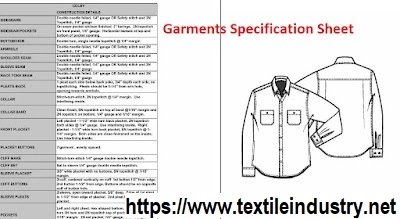Garments Specification Sheet
A garments specification sheet is also known as a spec (Spec is a short form of Specification) sheet, some customer calls it Product data management (PDM). A garments spec sheet is also known as a Tech pack; a tech pack stands for Technical package or Technical packet. So PDM, spec sheet, tech pack, or specification sheet whatever we call that function is the same. A garments specification sheet is a complete technical data sheet that contains a Bill of material (BOM), garment construction, measurement data, measurement tolerances, labeling information, sticker attachment information, and folding and packing information. That is why the garments specification sheet is very much important. After getting the order confirmation, buying house merchandiser sends the specification to the factory/ vendor merchandiser. The garments specification sheet is very important for the merchandiser, Quality team, and Buyer QC; an export order cannot be executed without it as all the necessary information is mentioned here. The sample section and merchandiser coordinate everything by spec sheet during the product development/ sampling stage. Once the sample gets approval, the garment maker may follow the approved sample.
Without the specification sheet, production and PP meeting will not be started. So it has a huge value in the garment manufacturing process.

List of information/ data found in a Garments specification sheet
- Product sketch or design of front and back
- Product Description
- Product category, group, product code, and style name
- Bill of material (BOM)
- Garments Construction and necessary instruction to sew
- Fabrics Specification
- Label instruction
- Points of measurements and their upper & lower tolerances
- Size-wise measurements
- Art-work
- Sticker attaching instruction
- Wash and Ironing/ pressing instruction
- Embroidery and printing placement (If any)
- Folding instruction
- Packing instruction
Description of Garments Specification Sheet
Product sketch or design of front and back: Just design or sketch pictures of a front and a back part that shows all parts of a garment. The product sketch is very much clear to shows what a product is looking like.
Product Description: Every garment product has a description that is fixed by buyers based on design and marketing factors.
Product category, group, product code, and Style name: There are various types of product categories like outerwear, activewear, workwear, and many others; the group like Men’s, boys, etc. Buying house issuing orders by product category and group-wise; color, size, and construction vary in the same group.
Bill of material (BOM): BOM stands for “Bill of material”, a BOM sheet contains all the material needed for a product with all necessary information consumption, cost, color, size, item code, and other information. BOM sheet data have full information to make a full single product with all materials (Fabrics, Zipper, Button, Label, sticker). In one word, the BOM sheet has all trims and accessories details.
BOM sheet information: –
Material Name
Material Consumption
Item Code
Material Color
Cost of Material
Vendor/ Supplier name
Quantity to be used in one single product
Material specification
Trims and Accessories details
Garments Construction and necessary sewing instruction: This information needs for all to know how to sew to full garments, what are steps to follow, seam length, width, and full detail of sewing. Every sewing process by stitch name is clearly mentioned in the spec sheet.
Fabrics Specification: Fabric specification is very important as it takes garments 60 % cost. Among the specifications of fabric Construction, fabric color, wash type, fabric GSM, fabric composition, and roll width these few factors are very important to maintain according to spec. An example of fabric specification is Cotton 98%, Spandex 2%, width: 59/61 inch, and Color: Black indigo.
Label information and instruction: Care and other label design and placement are mentioned in the spec sheet.
Points of measurements and their upper & lower tolerances: All the measuring points, measurement specifications, and point-wise tolerance are also in the spec sheet.
Size-wise measurements: Every garment product has 5/6 types of size. Measurement differs according to size but the point of measurement remains the same.
Artwork: All sticker and label designs are in the specification sheet. Merchandising team source material seeing spec sheet design.
Sticker attaching and placement instruction: Every sticker has a certain placement requirement in the spec sheet.
Wash and Ironing/ pressing instructions: Fabrics wash name and pressing/ ironing requirements are also mentioned in the spec sheet. Some of the products do not have pressing, simply ‘no wash’ and ‘no press’ are given in the sheet. The Spec sheet mentions specifically ironing with steam or not.
Embroidery and printing placement (If any): Some of the garment items have Embroidery or printing requirements that are clearly mentioned in the spec sheet with design and placement.
Folding instruction: Folding differs product by product type; di-fold, tri-fold, and quad-fold are examples of folding types. The garments spec sheet mentions full folding details with pictures so that vendors can understand easily.
Packing instructions: How to pack and keep in a carton is needed to know. Garments manufacturers are bound to follow customer spec sheets.
